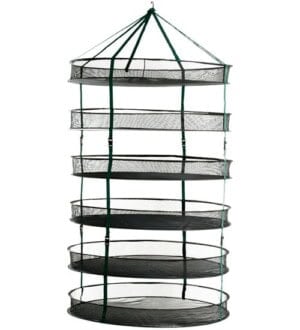In many parts of the country, the beginning of August is the time to harvest and dry herbs. Many leafy herbs have budded and are ready to flower… the perfect time to harvest for drying. Herbs at this stage — just ahead of flowering — have the most flavorful, aromatic oils. Some herbs — basil, rosemary, lemon balm, parsley and rosemary — can be harvested multiple times over the course of the summer. It’s best to harvest in the morning after the dew has dried. Inspect your pickings carefully for dead or diseased leaves or signs of mold. Most herbalists recommend rinsing herbs and gently shaking them dry. We’ve always felt that rinsing removes valuable oils and try to keep it at a minimum, especially after a previous day’s rain.

#1 DRYING RACK
STACK!T
Made of breathable mesh that allows for quick drying and maximum ventilation.
Learn moreDon’t waste your harvest! We offer the best garden scissors and snips for quick, clean cuts and our hanging drying racks will preserve your precious bounty keeping it safe until ready to use.
Herbs with a lower moisture content — oregano, thyme, rosemary, marjoram, savory, dill, sage — do well with hanging and air drying. They may be simply inverted, the stems bound together by string, and hung from a rafter or any overhang that allows circulation around the entire bunch. Keep your herbs from exposure to sunlight. Check frequently for signs of mold or mildew. Back in the rainy Pacific Northwest, we used to hang bunches of herbs in our barn and with luck and a week’s worth of dry weather, would have success. (We eventually bought a food dehydrator to avoid our mold problems.) Some herbalists, in an effort to keep their herbs from dust and other contaminants, suspend their herbs in a brown paper bag poked through with plenty of ventilation holes.
Herbs with a high moisture content — mints, tarragon, basil — are best dried using a food dehydrator or the oven technique to prevent mold from forming. Oven drying requires spreading herbs in a single layer evenly across a cookie sheet and setting the temperature at the lowest setting, often 150 degrees or less. If this temperature is hard to maintain — and it is with most ovens — try turning your oven on for only five minutes every hour. Turn and rearrange your herbs at this time. In three hours or so, leaves should be crispy and ready to store. In her book The Whole Herb, Barbara Pleasant suggests using the microwave to dry small batches of herbs. Arrange them on a plate and microwave for 15 to 30 seconds before letting them cool completely and repeating the process. If after several cycles, you find that the leaves are ready but the stems are still moist, she suggests you finish them off in a warm oven.

Dried herbs are best stored in jars with tight fitting lids. Remember that when using dried herbs in your favorite recipe, they are three to four times stronger than fresh herbs… depending on how well you dried them. There’s nothing like opening a jar of dried herb — say thyme, rosemary or oregano — in the dead of winter and having the scent remind you of the glorious August day you picked it and set it to drying. Detailed instructions on harvesting, drying and storing herbs can be found here.
As in all gardening discussions, there are disagreements as to the best methods of drying herbs. Jim Long, author of the pamphlet Growing & Using the Top 10 Most Popular Herbs says that herbs should never be dried in the microwave. Too much of their oil is lost in the process. He’s also against hanging herbs up to dry “in little bundles in the kitchen. While they look pretty, it’s not a good way to dry them if you plan on using them for cooking afterward.” Best, he suggests, is the food dehydrator, or in a warm dark place, like an attic. Help us here, dear readers and fellow herb growers: what’s your favorite method for preserving herbs?











